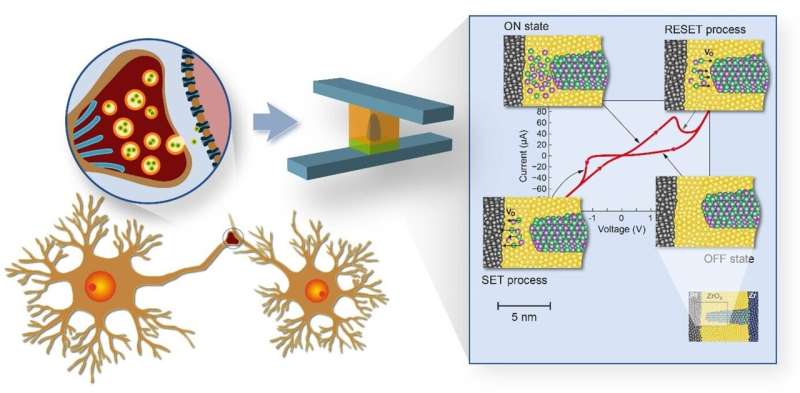Synapses as a model: Solid-state memory in neuromorphic circuits

Certain tasks—such as recognizing patterns and language—are performed highly efficiently by a human brain, requiring only about one ten-thousandth of the energy of a conventional, so-called "von Neumann" computer. One of the reasons lies in the structural differences: In a von Neumann architecture, there is a clear separation between memory and processor, which requires constant moving of large amounts of data. This is time- and energy-consuming—the so-called von Neumann bottleneck. In the brain, the computational operation takes place directly in the data memory and the biological synapses perform the tasks of memory and processor at the same time.
In Forschungszentrum Jülich, scientists have been working for more than 15 years on special data storage devices and components that can have similar properties to the synapses in the human brain. So-called memristive memory devices, also known as memristors, are considered to be extremely fast and energy-saving, and can be miniaturized very well down to the nanometer range. The functioning of memristive cells is based on a very special effect: Their electrical resistance is not constant, but can be changed and reset again by applying an external voltage, theoretically continuously. The change in resistance is controlled by the movement of oxygen ions. If these move out of the semiconducting metal oxide layer, the material becomes more conductive and the electrical resistance drops. This change in resistance can be used to store information.
The processes that can occur in cells are complex and vary depending on the material system. Three researchers from the Jülich Peter Grünberg Institute—Prof. Regina Dittmann, Dr. Stephan Menzel, and Prof. Rainer Waser—have therefore compiled their research results in a detailed review article, "Nanoionic memristive phenomena in metal oxides: the valence change mechanism." They explain in detail the various physical and chemical effects in memristors and shed light on the influence of these effects on the switching properties of memristive cells and their reliability.
"If you look at current research activities in the field of neuromorphic memristor circuits, they are often based on empirical approaches to material optimization," said Rainer Waser, director at the Peter Grünberg Institute. "Our goal with our review article is to give researchers something to work with in order to enable insight-driven material optimization." The team of authors worked on the approximately 200-page article for ten years and naturally had to keep incorporating advances in knowledge.
"The analogous functioning of memristive cells required for their use as artificial synapses is not the normal case. Usually, there are sudden jumps in resistance, generated by the mutual amplification of ionic motion and joule heat," explains Regina Dittmann of the Peter Grünberg Institute. "In our review article, we provide researchers with the necessary understanding of how to change the dynamics of the cells to enable an analog operating mode."
"You see time and again that groups simulate their memristor circuits with models that don't take into account high dynamics of the cells at all. These circuits will never work," said Stephan Menzel, who leads modeling activities at the Peter Grünberg Institute and has developed powerful compact models that are now in the public domain. "In our review article, we provide the basics that are extremely helpful for a correct use of our compact models."
Roadmap of neuromorphic computing
The "Roadmap of Neuromorphic Computing and Engineering," which was published in May 2022, shows how neuromorphic computing can help to reduce the enormous energy consumption of IT globally. In it, researchers from the Peter Grünberg Institute (PGI-7), together with leading experts in the field, have compiled the various technological possibilities, computational approaches, learning algorithms and fields of application.
According to the study, applications in the field of artificial intelligence, such as pattern recognition or speech recognition, are likely to benefit in a special way from the use of neuromorphic hardware. This is because they are based—much more so than classical numerical computing operations—on the shifting of large amounts of data. Memristive cells make it possible to process these gigantic data sets directly in memory without transporting them back and forth between processor and memory. This could reduce the energy efficiency of artificial neural networks by orders of magnitude.
Memristive cells can also be interconnected to form high-density matrices that enable neural networks to learn locally. This so-called edge computing thus shifts computations from the data center to the factory floor, the vehicle, or the home of people in need of care. Thus, monitoring and controlling processes or initiating rescue measures can be done without sending data via a cloud.
"This achieves two things at the same time: you save energy, and at the same time, personal data and data relevant to security remain on site," says Prof. Dittmann, who played a key role in creating the roadmap as editor.
The associated studies were published in Advances in Physics and Neuromorphic Computing and Engineering.
More information: Regina Dittmann et al, Nanoionic memristive phenomena in metal oxides: the valence change mechanism, Advances in Physics (2022). DOI: 10.1080/00018732.2022.2084006
Dennis V Christensen et al, 2022 roadmap on neuromorphic computing and engineering, Neuromorphic Computing and Engineering (2022). DOI: 10.1088/2634-4386/ac4a83

















